
UNESCO inscribes various sites, customs, and practices to its World Heritage List. Sites that are considered to have exceptional universal importance are included in this list of cultural and natural heritage sites. A site’s inclusion on the list recognizes its importance and attempts to safeguard and preserve it for future generations.
The Great Wall of China, the Egyptian Pyramids, and the Taj Mahal are just a few examples of famous sites that have been inscribed. Other natural wonders on the list include the Serengeti National Park in Tanzania and the Great Barrier Reef in Australia. In addition, UNESCO recognizes and preserves intangible cultural heritage components including traditional music, dance, and handicraft.
The World Heritage Committee of UNESCO conducts a thorough review as part of the inscription process. Member states submit nominations for inscription, which are rigorously evaluated to determine their exceptional universal worth. When making decisions, the committee considers elements including historical importance, architectural or natural attractiveness, and cultural significance.
Once a site is listed on the World Heritage List, the World Heritage Convention’s worldwide assistance and protection are then available to it. This includes financial support, technical know-how, and the development of community capacity for conservation projects. The promotion of inscribed sites as tourist hotspots aids in both the economic growth of such locations and the maintenance of environmentally responsible tourism.
Taking these facts into consideration, UNESCO has inscribed many tangible and intangible heritage sites in Ethiopia. The Rock-Hewn Churches of Lalibela are among the most noteworthy. These 11 medieval monolithic churches were cut out of solid rock in the 12th century and are considered one of the world’s most astonishing architectural wonders.
In Gondar, there is a castle called Fasil. During the 17th and 18th centuries, Ethiopian rulers lived in this stronghold city. It is noted for its distinct architectural style, which incorporates inspirations from several cultures such as Axumite, Arabian, Indian, and European.
The Meskel celebration: This religious celebration honors Queen Helena’s finding of the True Cross in the fourth century. It consists of a massive bonfire being lit, religious processions, and songs and dance performances. These are just a few of the tangible and intangible cultural heritages recognized by UNESCO in Ethiopia.

Currently, UNESCO has registered the Gedeo Cultural Landscape in the Gedeo zone in South Ethiopia as a world heritage site. The registration of Gedeo Cultural Landscape was declared at the 45th extended session of the World Heritage Committee, which is now taking place in Riyadh, Saudi Arabia from September 10 to September 25, 2023, in the presence of Ethiopia’s Minister of Tourism delegations. The Gedeo Cultural Landscapes brings Ethiopia’s total number of UNESCO-inscribed cultural and natural heritages to ten, making it Africa’s 100th.
The Simien National Park: Located in northern Ethiopia, this national park is recognized for its stunning landscapes, which include the Rocky Mountains, deep valleys, and abrupt precipices. It is home to a number of endemic animals, including the Ethiopian wolf and the Walia ibex.
The Konso Cultural Landscape is distinguished by terraced fields, stone-walled communities, and grave markers known as waka. For nearly 400 years, the Konso people have practiced sustainable agriculture and land management approaches.
Ethiopian Ministry of Tourism Minister Ambassador Nasise Chale said that the Gedeo people are engaged in multilayer cultivation of huge trees, grains, and Yirgacheffe coffee, which is well renowned for its exceptional flavor.
The Gedeo people, according to the minister, are an example of indigenous peoples for their expertise on how to preserve the ecosystem and land. Noting that the Gedeo cultural landscape is one of the fantastic tourism attraction resources of the South Ethiopia region, she claimed that one of the elements that make the Gedeo cultural landscape are the ancient megalithic stelae monuments, which are thought to be the oldest in East Africa.
Indeed, the area is home to approximately 6,000 megalithic stelae with fascinating imagery for researchers and tourists from abroad and locally. The forest, which has been preserved for many years, is part of the legacy. The community there engages in multilayer agriculture, which further distinguishes the location. The minister acknowledged that Gedeo’s Cultural Landscape legacy demonstrates how people can coexist with nature by housing numerous birds, animals, and crops in addition to displaying how the community interacts and lives.
Ethiopian Heritages Protection Authority Director General Abebaw Ayalew for his part said that in cooperation with the community, the Ethiopian government has been carrying out a number of initiatives aimed at conserving the heritage.
Members of the UNESCO heritages committee emphasized that the inscription of the Gedeo Cultural landscape by UNESCO will allow the heritage to get long-term protection and that the registration will also help it to be a popular tourist destination.
Twelve years after Konso was added to the list of the world’s cultural and natural heritage sites, UNESCO officially recognized the Gedeo Cultural Landscape. On the rocky escarpments of the Ethiopian highlands, it is situated along the Main Ethiopian Rift’s eastern margin. Additionally, it is a region of agroforestry, using layered agriculture with enormous trees protecting indigenous enset, the principal food crop, under which grow coffee and other plants.
According to UNESCO, the Gedeo people, whose traditional knowledge supports local forest management, represent a significant portion of the area’s population. Along the mountain ridges are dense clusters of megalithic monuments, which the Gedeo learned to revere and which their elders looked after. Sacred forests inside the farmed mountain slopes have historically been used by local communities for ceremonies linked with the Gedeo religion.
Ethiopia benefits in a number of ways from the inscription of tangible and intangible cultural heritages by UNESCO. It benefits the nation economically, fosters internal and external cooperation for the joint development of tourism attractions, and aids in cultural preservation and conservation.
Furthermore, UNESCO’s recognition attracts tourists from around the world who are interested in experiencing and learning about the Gedeo Cultural Landscape heritage. This boosts the local economy through increased tourism revenue, job creation, and the development of supporting industries.
It also promotes the exchange of knowledge, experiences, and best practices for maintaining and developing cultural variety, as well as building mutual understanding and tolerance. In general, UNESCO’s inscription of Ethiopian tangible and intangible cultural heritages brings numerous benefits that contribute to the preservation, promotion, and appreciation of these valuable aspects of Ethiopian culture in particular, and the Gedeo Cultural Landscape in general which is imperative for future generations.
BY EPHREM ANDARGACHEW
THE ETHIOPIAN HERALD TUESDAY 17 OCTOBER 2023




